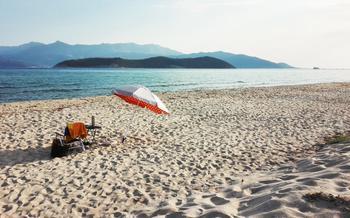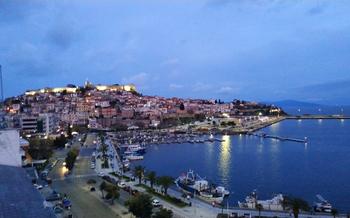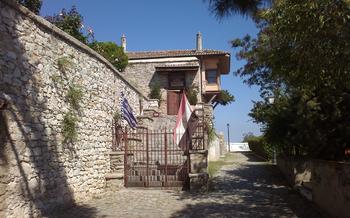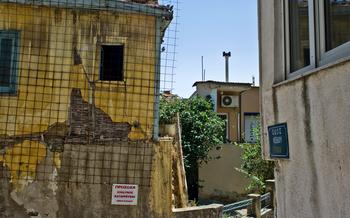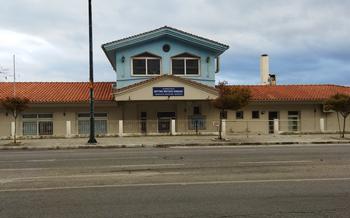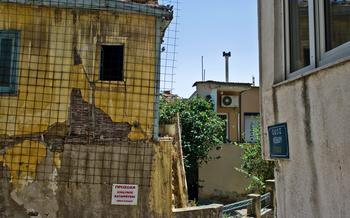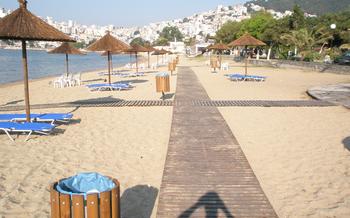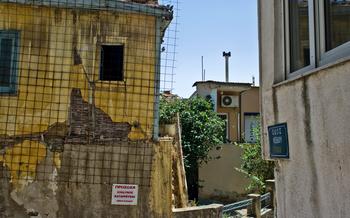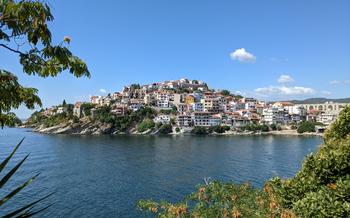
The Fossilized Forest of Keramoti
- The Fossilized Forest of Keramoti: A Natural Wonder
- Location and Accessibility
- What to Expect at the Fossilized Forest
- Nearby Attractions
- Where to Eat and Drink
- Where to Stay
- Historical Significance
- Paleontological Discoveries
- Educational Value
- Conservation Efforts
- Local Legends and Myths
- Personal Experience
The Fossilized Forest of Keramoti: A Natural Wonder
Nestled along the serene coast of Kavala, Greece, lies a captivating natural wonder that has stood the test of time – the Fossilized Forest of Keramoti. This ancient petrified forest, estimated to be millions of years old, offers a glimpse into a bygone era when lush vegetation thrived in this region. Its exceptional geological significance lies in its abundance of fossilized trees, leaves, shells, and other marine life, providing invaluable insights into past climate conditions and the evolution of ecosystems. As a unique tourist attraction, the Fossilized Forest of Keramoti beckons travelers to explore its awe-inspiring landscapes and discover the secrets of a long-lost world. Prepare to be mesmerized by the intricate details preserved in stone, as this remarkable forest unveils the wonders of nature's artistry.
Location and Accessibility
The Fossilized Forest of Keramoti is conveniently located just a short drive from the city of Kavala, making it an ideal day trip for visitors. To reach the forest by car, simply follow the signs from Kavala to Keramoti. The journey takes approximately 30 minutes and offers scenic views of the surrounding countryside.
For those without their own transportation, public transportation is also available. Several buses depart from Kavala's central bus station daily and stop near the entrance to the forest. The bus ride takes slightly longer than driving, but it provides a budget-friendly option for travelers.
Once you arrive at the forest, you will find ample parking facilities available. There is a designated parking area near the entrance, where you can leave your vehicle for a small fee. This fee helps to support the maintenance and preservation of the forest.
What to Expect at the Fossilized Forest
The fossilized forest offers a range of experiences for visitors, including well-marked walking trails that cater to different interests and abilities. The main trail, stretching approximately 2 kilometers, takes you through the heart of the forest, showcasing the most impressive specimens of fossilized trees. Along the way, information signs provide insights into the geological history of the site, the types of fossils ditemukan, and the significance of the forest's preservation.
In addition to the main trail, there are shorter, easier paths suitable for families with young children or visitors seeking a more leisurely stroll. These trails offer a glimpse into the forest's diverse flora and fauna, including the unique vegetation that has adapted to the unique soil conditions.
At the visitor center, you can find interactive exhibits and educational displays that delve deeper into the forest's paleontological and geological significance. Fossil specimens, replicas, and multimedia presentations bring the ancient world to life, providing a comprehensive understanding of the forest's history and its role in shaping the region's landscape.
Nearby Attractions
The Fossilized Forest of Keramoti is surrounded by a wealth of other attractions that are worth exploring. For those seeking a refreshing dip and some sun-soaked relaxation, the nearby Nea Peramos Beach beckons with its golden sands and sparkling waters. Just a short drive away, Ammolofoi Beach offers a more secluded haven, with its crystal-clear waters and stunning views of the surrounding landscape.
To delve into the region's rich history and culture, the Archaeological Museum of Kavala is a must-visit. Here, visitors can admire an array of ancient artifacts that shed light on the area's fascinating past. The Imaret, a beautifully preserved Ottoman-era building, further showcases the region's cultural heritage, with its impressive architecture and intriguing exhibits.
Whether you seek sun, history, or culture, the surroundings of the Fossilized Forest of Keramoti offer an abundance of experiences to enrich your visit.
Where to Eat and Drink
After exploring the ancient wonders of the fossilized forest, satisfy your taste buds with the culinary delights of the region. Kavala and its surroundings offer a diverse range of dining options, from traditional Greek tavernas to charming cafés and bars.
For an authentic Greek experience, head to one of the local tavernas in Nea Peramos or Kavala. These family-run establishments serve up fresh seafood, grilled meats, and traditional dishes prepared with local ingredients. Enjoy the warm hospitality and savor the flavors of Greece while dining al fresco with a view of the sparkling sea.
If you prefer a more casual atmosphere, there are several cafés and bars in the area where you can relax with a refreshing drink or a light snack. Sip on a fragrant Greek coffee or indulge in a sweet treat while taking in the stunning views of the Aegean Sea.
For a picnic amidst nature, pack a basket of local delicacies and head to one of the designated picnic spots within or near the fossilized forest. Spread out a blanket under the shade of the trees and savor a leisurely meal surrounded by the tranquil beauty of the natural surroundings.
Where to Stay
Kavala, the vibrant city neighboring the Fossilized Forest of Keramoti, offers a diverse range of accommodation options to suit every traveler's preferences and budget. Whether seeking the comfort of a luxurious hotel, the privacy of a self-catered apartment, or the thrill of camping amidst nature, visitors are spoilt for choice.
For those seeking a convenient and comfortable stay, Kavala boasts an array of hotels ranging from cozy guesthouses to opulent resorts. These establishments offer a variety of amenities to cater to travelers' needs, including stunning sea views, rooftop pools, and delectable dining options.
For a more independent and homely experience, visitors can opt for apartments and villas scattered throughout Kavala. These rentals provide the freedom to cook meals, unwind in private spaces, and enjoy the flexibility of a home away from home.
For adventure enthusiasts seeking a unique and immersive experience, camping grounds near the forest offer the opportunity to connect with nature and embrace the tranquility of the surroundings. These campsites provide basic facilities such as restrooms, showers, and designated tent areas, ensuring a comfortable stay in the heart of the natural wonders.
Historical Significance
The Fossilized Forest of Keramoti holds immense historical significance, serving as a testament to the region's rich geological and cultural past. Formed millions of years ago, the forest offers a glimpse into the Earth's ancient history. Its fossilized trees, once towering giants, now stand as silent witnesses to the passage of time.
Geological evidence suggests that the forest was once a lush, thriving ecosystem, teeming with life. Over time, tectonic shifts and natural disasters led to the submergence of the forest beneath the sea. The weight of the overlying sediments and the chemical processes of fossilization transformed the trees into the remarkable stone structures we see today.
Archaeological findings in the area further support the region's historical significance. Discoveries of ancient tools, pottery fragments, and other artifacts indicate human activity in the vicinity of the forest thousands of years ago. These findings hint at the cultural significance of the forest, which may have been a sacred site or a source of natural resources for early civilizations.
Today, the Fossilized Forest of Keramoti stands as a symbol of resilience and continuity. It has endured countless geological and historical events, serving as a reminder of the Earth's ever-changing nature and the enduring power of nature.
Paleontological Discoveries
The Fossilized Forest of Keramoti is a treasure trove of paleontological wonders. In addition to the fossilized trees, the site has yielded a rich diversity of other plant and marine fossils. Among the fossilized plants, visitors can observe a variety of tree species, including conifers, cycads, and ginkgo trees. These trees provide valuable insights into the ancient flora of the region and its evolution over millions of years.
Furthermore, the forest contains an abundance of marine fossils, including shells, corals, and other marine organisms. These fossils offer a glimpse into the diverse marine ecosystem that once existed in this area. The presence of these marine fossils suggests that the forest was once a coastal environment, which gradually transformed into a terrestrial environment over time due to geological processes.
The paleontological discoveries made at the Fossilized Forest of Keramoti have contributed significantly to our understanding of past ecosystems and climate conditions. They provide valuable evidence for the evolution of life on Earth and the dynamic nature of our planet's environment.
Educational Value
The Fossilized Forest of Keramoti offers an exceptional educational experience for visitors of all ages. School field trips are a common sight, as the forest provides an ideal outdoor classroom for geology and natural history lessons. Interactive displays and hands-on exhibits engage visitors, allowing them to learn about the forest's unique features and the geological processes that shaped it. Educational workshops and events organized by the forest's management further enhance the learning experience, providing in-depth insights into the scientific and cultural significance of the site.
Conservation Efforts
The Fossilized Forest of Keramoti is not just a tourist attraction; it also holds significant scientific and educational value. As such, protecting and preserving this natural wonder is of utmost importance. The local authorities and environmental organizations have implemented several conservation measures to safeguard the forest and its fossils.
One crucial aspect of conservation involves limiting human impact on the site. Visitors are encouraged to stay on designated paths and avoid touching or damaging the fossils. The forest is also monitored regularly to prevent illegal activities, such as fossil collection or vandalism.
Environmental education plays a vital role in promoting conservation awareness. The visitor center at the forest offers educational programs and workshops for students and visitors, highlighting the importance of protecting natural heritage. Interactive displays and signage provide information about the geological and ecological significance of the site, fostering a sense of appreciation and responsibility among visitors.
Additionally, the forest management promotes sustainable tourism practices. By encouraging responsible behavior, such as minimizing waste and respecting the environment, visitors can help preserve the forest's integrity while enjoying its unique attractions.
Local Legends and Myths
The Fossilized Forest of Keramoti is not only a geological wonder but also a source of inspiration for local legends and myths. According to ancient Greek mythology, the forest was once a thriving woodland inhabited by nymphs and other mythical creatures. One legend tells the tale of a beautiful nymph named Dryope who was transformed into a tree by the gods as punishment for picking lotus flowers. Her son, Hylas, searched tirelessly for his mother, but he never found her. Instead, he encountered the fossilized remains of the forest, which he believed to be the remnants of Dryope's beloved trees.
Local folklore also weaves tales of hidden treasures buried beneath the fossilized trees. Some believe that the forest holds the secrets of ancient civilizations, waiting to be discovered by those who are worthy. Others say that the fossilized trees possess magical properties and can bring good luck or healing to those who touch them.
The cultural heritage of the region is deeply intertwined with the Fossilized Forest. Local artists and writers have drawn inspiration from the forest's unique beauty and its rich history, creating works of art, literature, and music that celebrate its significance. The forest stands as a symbol of resilience and continuity, connecting the past with the present and inspiring generations to come.
Personal Experience
My visit to the Fossilized Forest of Keramoti was a truly awe-inspiring experience. As I wandered among the ancient petrified trees, I couldn't help but feel a sense of wonder and connection to the past. The sheer size and scale of the fossilized trunks were breathtaking, and it was fascinating to imagine what this forest must have been like millions of years ago.
One of the highlights of my visit was discovering a hidden gem within the forest—a secluded clearing that offered a panoramic view of the surrounding landscape. It was the perfect spot to sit and contemplate the beauty of nature and the passage of time.
As I left the forest, I felt a deep sense of gratitude for having had the opportunity to witness such a remarkable natural wonder. The Fossilized Forest of Keramoti is a place that will stay with me long after my visit, and I highly recommend it to anyone who is interested in geology, history, or simply the wonders of the natural world.
